#evtol
Photo
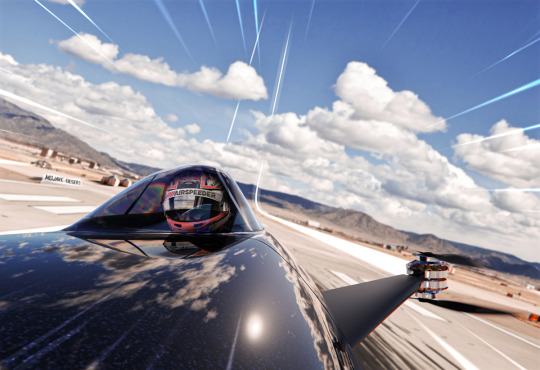



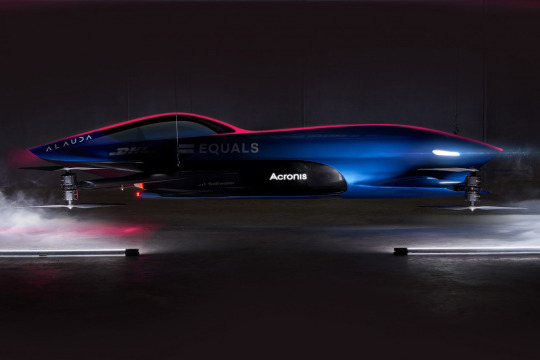
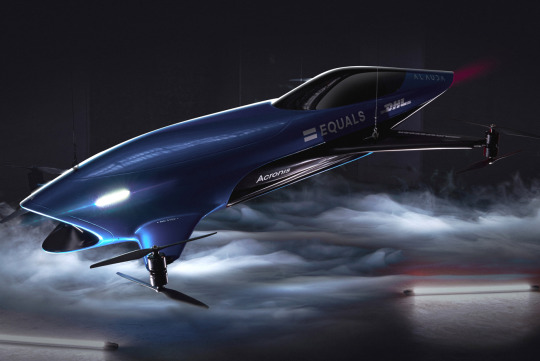
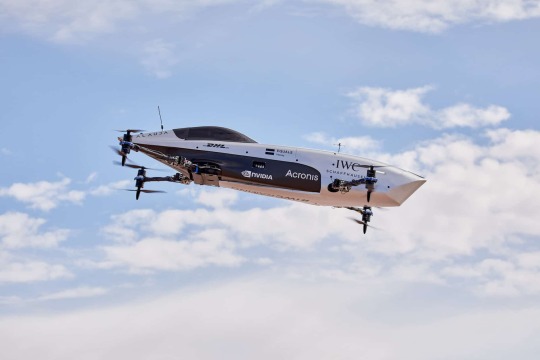
Alauda's Airspeeder MK-4
The company said in a statement that the one-person electric racing machine will have a top speed of 225 mph, and potential range of 180 miles.
It will be powered by a Thunderstrike Hydrogen Turbogenerator connected to electric motors on the eVTOL wings.
#art#design#evtol#vtol#racing#sports#alauda#airspeed#MK-4#hydrogen#trurbogenerator#vtol aircraft#evtol aircraft market#FLYING PRIVATE#AI
80 notes
·
View notes
Text
La toute première voiture volante passe le test de sécurité au Japon et pourrait être en vente d’ici 2025

Cette voiture a obtenu le premier certificat de sécurité délivré par le Japon, leur permettant de commercialiser leurs véhicules eVTOL dès 2025. Il s’agit de la première voiture volante à atteindre ce stade au Japon, et pourrait ouvrir la voie pour que cette décennie soit la décennie de voitures volantes. Le concept de voiture volante électrique eVTOL de SkyDrive est actuellement représenté par le SD-03 , qui a fait une démonstration de vol habité réussie en août 2020. Ne transportant qu’un seul siège, le SD-03 est propulsé par huit hélices en formation quadricoptère et dispose d’une gamme de environ 10 minutes de vol, atteignant des vitesses maximales 48 kilomètres par heure.

Lors de la première mondiale, un pilote a décollé verticalement avant de voler autour d’une zone d’essai et de redescendre en douceur 5 janvier 2023
10 notes
·
View notes
Text

Nouveau Kit pour moto

• Nouvelle génération de kit adaptable pour moto.
• Système de navigation simplifié.
• Moto entre 750cc et 1300cc
• Un moteur électrique remplace la roue arrière pour alimenter les turbines électriques.
• Chaque turbine a 2 moteurs et 2 hélices connectées qui tournent dans des sens opposés
• Vitesse maxi + 280 km/h.
• Autonomie 200kms
• Bio Fuel + petite batterie pour atterrissage d'urgence
• il est conçu pour voler entre 1 m et max 100 m d'altitude...
6 notes
·
View notes
Text
Weekly output: applied AI, open innovation, Mastodon updates, AI equity, 1Password, Signal, Eve Air Mobility, travel tech, travel tips
After getting back from Brazil early Saturday morning, I’ve napped more than usual but have also spoken at an event in D.C., gotten in some gardening, and enjoyed a shorter-than-usual bike ride.
5/1/2023: Companies adopting AI need to move slowly and not break things, Fast Company
I wrote about how two companies I’ve covered elsewhere recently–the satellite-imagery firm Planet and the…

View On WordPress
#1Password#AI#air taxi#Bluesky#Brasil#Brazil#Eve Air Mobility#eVTOL#frequent flyer#FTU#FTU DC#Intercom#Mastodon#miles and points#Planet#Rio de Janeiro#Signal#travel hackers#Web Summit#Web Summit Rio
2 notes
·
View notes
Text
Urban Air Mobility Market: Trends, Challenges, and Future Prospects
The urban air mobility (UAM) market is poised for significant growth, driven by the need for sustainable and efficient transportation solutions in urban areas. The market size is projected to exceed USD 15533.29 million by 2028, growing at a CAGR of 11.13% during the forecast period. This growth is attributed to the increasing demand for fast and effective transportation, rising environmental concerns, and advancements in technology for the UAM industry.
Market Size and Growth
The global UAM market size was valued at USD 3.8 billion in 2023 and is expected to reach USD 28.5 billion by 2030, growing at a CAGR of 33.5% from 2023 to 2030
This rapid growth is driven by the need for fast and effective transportation, rising environmental concerns, and advancements in technology for the UAM industry. The market is driven by factors such as growing smart city initiatives, a rise in environmental concerns, and increasing advancements in technology for UAM Industry.
Key Players
The key players in the UAM market include Airbus SE (Netherlands), Lilium Aviation Gmbh (Germany), EHang (China), Eve Holding Inc(Brazil), Vertical Aerospace (UK), and Textron Inc(US)
These companies are investing heavily in research and development, product launches, mergers & acquisitions, collaborations, partnerships, and refurbishing of existing technology to stay ahead in the market.
Challenges
Despite the growth prospects, the UAM market faces several challenges, including higher initial investment required for research & development and for developing required infrastructure development for UAM
The industry players are investing a lot of effort in the research and development of smart and unique strategies for sustainable transportation systems. However, safety concerns and public trust are critical factors for UAM adoption, and the market growth is expected to be hampered by these challenges
Future Prospects
The future of UAM looks promising, with the market expected to reach USD 30.7 billion by 2031, growing at a CAGR of 30.2% from 2022 to 2031
The UAM market is expected to transform the way we commute, deliver goods, and experience cities. The concept of UAM has taken flight in recent years, promising a revolution in urban transportation. As cities continue to expand and traffic congestion worsens, the need for innovative solutions for efficient, fast, and sustainable transportation within urban environments becomes increasingly pressing.
Infrastructure Development
One of the most significant challenges in implementing UAM lies in the development of a comprehensive infrastructure
This includes the creation of landing pads, charging infrastructure, and air traffic management systems. The development of infrastructure is critical for the widespread adoption of UAM.
Regulatory Landscape
The regulatory landscape is also a significant challenge for the UAM market. Governments and regulatory bodies need to establish clear guidelines and regulations for the operation of UAM vehicles, including issues such as noise pollution, air traffic control, and safety standards.
Public Acceptance
Public acceptance is another critical factor for the growth of the UAM market. The public needs to be educated about the benefits of UAM, including reduced congestion, reduced emissions, and increased efficiency. Public acceptance is critical for the widespread adoption of UAM.
Conclusion
In conclusion, the UAM market is poised for significant growth, driven by the need for sustainable and efficient transportation solutions in urban areas The market size is projected to exceed USD 15533.29 million by 2028, growing at a CAGR of 11.13% during the forecast period The key players in the UAM market are investing heavily in research and development, product launches, mergers & acquisitions, collaborations, partnerships, and refurbishing of existing technology to stay ahead in the market. However, the market faces several challenges, including higher initial investment required for research & development and for developing required infrastructure development for UAM The future of UAM looks promising, with the market expected to reach USD 30.7 billion by 2031, growing at a CAGR of 30.2% from 2022 to 2031The UAM market is expected to transform the way we commute, deliver goods, and experience cities.
#Urban Air Mobility#UAM Market#Electric Vertical Take-Off and Landing#eVTOL#Urban Transportation#Sustainable Transportation#Future of Transportation
0 notes
Text
BETA Technologies Revolutionizes Air Travel | ALIA-250 eVTOLs in Greece
#BETA Technologies#beta technologies#evtol#beta technologies alia#air taxi#united therapeutics#alia 250#uber air taxi#air taxi flight test#beta alia electric aircraft#vtol air taxi#beta alia evtol#tactics for listening#golden age of flying#cable news#business news#ALIA-250 eVTOLs in Greece#alia-250 evtols in greece#Air Travel | ALIA-250 eVTOLs in Greece#air travel | alia-250 evtols in greece#BETA Technologies Revolutionizes#bnn#bnn breaking#xrp#eth
1 note
·
View note
Link
#Aircraft#electricverticaltake-offandlanding#eVTOL#Futurride#GhenusAir#hybridhydrogen#hydrogeneconomy#hydrogen-based#LA-44#LA-44XPrime#LA-44C#LyteAviation#LyteSkyBus#LyteSkyTruck#McKinsey&Company#OdysAviation#Plana#Ram#regionalairmobility#sustainablemobility#TraverseAero#UAM#UAV#urbanairmobility#VIPjetsserviceoperator#VManAviationServices
0 notes
Text




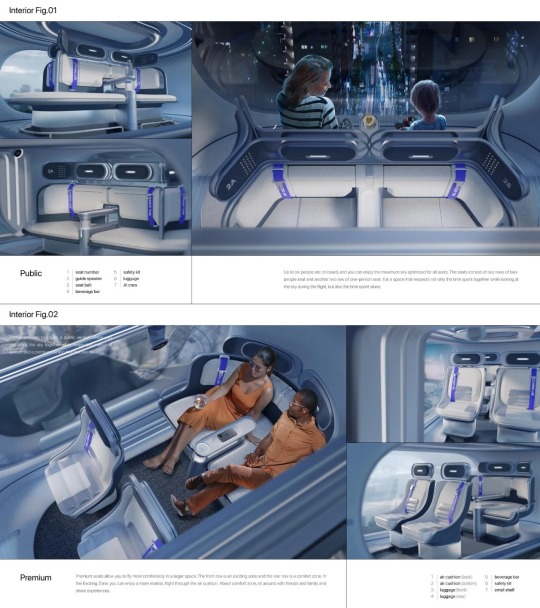

Linker eVTOL,
Courtesy: Joowon Lee
#art#design#flying private#travels#luxury lifestyle#flying palace#evtol#vtol#linker#joowon lee#concept#render#vtol aircraft#luxurylifestyle
21 notes
·
View notes
Text
El sueño de volar
Los sueños de volar algún día se harán realidad con los vehículos aéreos eléctricos de pasajeros. Desde Ícaro desafiando al sol con alas de cera hasta los Wright elevándose sobre Kitty Hawk, la humanidad ha estado obsesionada con surcar los cielos. Ahora, disruptivas startups prometen llevar esa fantasía a nuestras ciudades con taxis aéreos autónomos. Pero mientras visionarios como Lilium y Joby Aviation buscan que despeguemos hacia los suburbios, los autos eléctricos terrestres como los de Tesla ya recorren velozmente las carreteras. ¿Podrán los vehículos voladores personales sortear obstáculos regulatorios y de infraestructura para materializar su potencial? ¿O el futuro de la movilidad eléctrica seguirá atado al asfalto? Revisemos el panorama.

Los humanos han soñado con volar desde la antigüedad. Los primeros esfuerzos se centraron en emular el vuelo de las aves con alas artificiales. En el siglo IX, Abbas Ibn Firnas construyó unas alas rudimentarias y se lanzó desde una torre, planeando brevemente. En el Renacimiento, Leonardo Da Vinci diseñó varios prototipos de máquinas voladoras. Pero no fue hasta finales del siglo XVIII que los hermanos Montgolfier inventaron el globo aerostático, demostrando por primera vez que el vuelo era posible.
A mediados del siglo XIX, Sir George Cayley sentó las bases de la aerodinámica moderna al identificar las cuatro fuerzas que actúan sobre un avión. A principios del siglo 20, los inventores comenzaron a experimentar con autos voladores y aeronaves híbridas tierra-aire.
En 1903, los hermanos Wright lograron el primer vuelo propulsado y controlado en un avión más pesado que el aire. La Primera Guerra Mundial vio grandes avances en el diseño de aviones. En 1917, Glenn Curtiss desarrolló el Autoplane, considerado uno de los primeros diseños viables de un auto volador. En 1927, Charles Lindbergh cruzó el Atlántico en un vuelo transoceánico sin escalas.
En la década de 1930, Waldo Waterman creó varios prototipos exitosos de autos voladores que realizaron breves vuelos. Después, la Segunda Guerra Mundial trajo aviones a reacción y cohetes. Sin embargo, la tecnología y los materiales de la época limitaron el desarrollo en gran escala. La Segunda Guerra Mundial y la Guerra Fría desviaron los recursos e intereses hacia jets de combate y cohetes. No fue hasta la década de 1950 que nuevos intentos como el ConvAirCar Model 118 y el Aerocar Aero-Plane tuvieron algo de éxito, aunque eran complejos de operar. En 1969 el Apolo 11 aterrizó en la luna.
En la década de 1980, la Administración Federal de Aviación de EE. UU. estableció estándares de seguridad para vehículos de despegue y aterrizaje vertical. Esto renovó el interés y allanó el camino para desarrollos posteriores. Modelos notables de fines del siglo XX fueron el Avcen Jet Flying Car y el Moller Skycar M400. Sin embargo, los altos costos, la compleja logística y las limitaciones persistentes de almacenamiento de energía evitaron una adopción generalizada.

Ahora en las dos primeras décadas del siglo 21 hemos visto grandes avances en vehículos aéreos eléctricos para transporte urbano y regional. Compañías como Lilium, Joby Aviation y Archer Aviation están desarrollando taxis aéreos y vehículos de despegue y aterrizaje vertical eléctricos (eVTOLs) para viajes punto a punto más rápidos y sostenibles.
En 2006, el avión transitable PAL-V Liberty obtuvo la certificación de la Unión Europea para operar tanto en carreteras como en cielos. Otros como Terrafugia Transition están siguiendo un enfoque híbrido terra-aire. Mientras tanto, AeroMobil ha presentado prototipos de automóviles voladores de alta velocidad para 4 pasajeros.
China ha establecido una hoja de ruta ambiciosa para tener vehículos aéreos operativos masivamente en 2025. Compañías respaldadas como EHang ya tienen taxis aéreos autónomos funcionando en pruebas. Por otro lado, AirBus, Hyundai y Uber planean lanzar servicios aéreos urbanos en la próxima década. Con la electrificación, la autonomía y las asociaciones intersectoriales, es probable que veamos los vehículos voladores tripulados convertirse en una realidad común en los próximos años.
La compañía alemana Volocopter tiene el volador eléctrico Volocity, diseñado para trasladar 2 pasajeros sobre el entorno urbano sin necesidad de infraestructura adicional. Lilium, también alemana, trabaja en una aeronave eléctrica de despegue y aterrizaje vertical capaz de transportar a 4 pasajeros. En Estados Unidos, Joby Aviation construye el taxi aéreo eléctrico S4 con 4 plazas, ideal para entornos suburbanos.
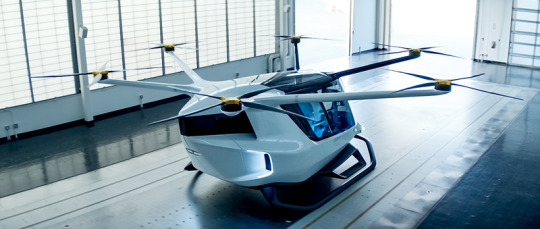
Skai Alaka'i Technologies Hopkinton, Massachusetts, USA. www.skai.co
Se pronostica que este nicho alcanzará 580 mil vehículos anuales en 2040. Empresas como Alaka'i y JetPack Aviation desarrollan prototipos de jets personales compactos impulsados por hidrógeno. La visión futura es que estos vehículos puedan estar al alcance de cualquier persona interesada en experiencias de vuelo personalizadas e innovadoras.
A pesar del entusiasmo por los vehículos aéreos eléctricos de pasajeros, su adopción masiva enfrenta desafíos. Los autos eléctricos terrestres ya tienen una infraestructura establecida de carriles, estaciones de carga y cadenas de suministro. La movilidad aérea urbana, por otro lado, debe resolver complejos rompecabezas regulatorios, de espacio aéreo, ruido y seguridad antes de materializarse.
El futuro de la movilidad aérea personalizada está despegando. Con innovadores vehículos eléctricos de despegue y aterrizaje vertical que transportan de 1 a 4 pasajeros, empresas visionarias lideran una revolución silenciosa y sostenible. Libres como pájaros, pronto cruzaremos ciudades abarrotadas pilotando nuestros propios taxis aéreos. El cielo es el límite para esta nueva era dorada de aviación personal.
¡Agárrate!
Gracias por leerme y compartir
@ptorresmx

1 note
·
View note
Text
Découvrez cette édition limitée de 52 pages, comprenant des innovations, des projets graphiques, des concepts de Drones, des eVTOL et des vertiports développés au fil des années à ce jour.
Une cinquante de concept...🚀
Tibo Cat Lion, Concepteur, Développeur, Designer, Chef de projet UAM et ancien fabricant de Drone.
FPV, DRONE D'INSPECTION, PHOTO VIDÉO, CARGO, SUIVI DE CHANTIER, ANTI DRONE, MÉDICAL, DE SURVEILLANCE, D’ÉPANDAGE, D’INCENDIE, D’INSPECTION DE CANALISATION, SÉCURITÉ CIVILE, EFFAROUCHEUR, EVTOL, AIRTAXI, JET, VERTIPORT, VERTISTATION, VERTIHUB,…
Couverture rigide, 52 pages de 135 gr A4 paysage -
https://www.linkedin.com/feed/update/urn:li:activity:7107238746193825792/
#drone#vertiport#air mobility command#vtol#evtol#evtol aircraft market#electricaviation#electrik#ingenierie#illustration
3 notes
·
View notes
Text
Weekly output: Mark Vena podcast, nearshoring meets remote coding, Eve air taxis
Between late last Sunday night and very early Saturday morning, I clocked more than 10,000 miles in the air to cover Web Summit Rio, conduct an onstage interview at that conference, and see very little of the city outside my conference bubble. Is that why I’m feeling tired tonight? No, the gardening work I put in yesterday and today had much more to do with that.
4/15/2024: Ep 98 SmartTechCheck…

View On WordPress
#air taxis#BairesDev#Eve Air Mobility#eVTOL#Nacho de Marco#nearshoring#Rio#Rio de Janeiro#Web Summit#Web Summit Rio
0 notes

